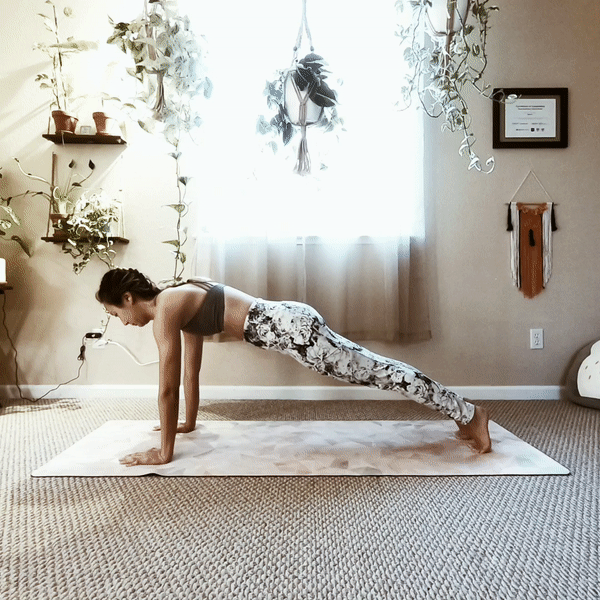To kick off this series of posture-specific guides, I will be getting into one of the most common sequences in a vinyasa-based class: the flow from High Plank all the way to Downward Facing Dog. While it only consists of up to 4 poses, it is one of the most important, foundational sequences in the vinyasa style. It is usually cued like this:
Exhale High to Low Plank
Inhale Upward Facing Dog or Cobra
Exhale Downward Facing Dog

* Disclaimer: While I am a certified yoga instructor, always consult a physician or qualified health professional for medical advice if you have any injuries (previous or current) or any other physical concerns before starting or changing any exercise regimen.

High Plank (Phalakasana)
To begin, plant your hands directly beneath your shoulders and step your feet all the way back. Aim to create one straight line from your heels to the crown of your head. Avoid dipping your hips too low (which puts pressure in your low back) or lifting your hips too high (which does not engage your core). Gaze down and slightly in front of your fingers to extend your spine long through your neck. Keep a micro-bend in your elbows to protect those joints, and press all of your fingers firmly down to create space between your shoulder blades and engage your upper back.

Low Plank or Four-Limbed Staff Pase (Chaturanga Dandasana)
The flow from High Plank to Low Plank is generally linked together in a single exhale. Despite its simplicity, it is one of the most difficult poses in yoga, not just to execute, but to do so with proper form, especially for new students. Don't let this intimidate you though, as there are a couple variations of Low Plank that you can take, depending on what your body needs. Be kind to yourself and take the time to build up the necessary strength to practice this pose safely.
(1) To transition from High Plank into the first variation of Low Plank, shift forward slightly onto your toes and bend your elbows to about 90 degrees. Maintain the long straight line from your heels to your crown, and pull your navel in to engage your core. Squeeze your elbows in towards your ribs to prevent them from splaying out wide. This variation requires strength in the arms, shoulders and abdominals. Preemptively shifting forward helps stack your elbows over your wrists when your elbows are bent, in order to take some strain off of your wrists.
(2) To build up strength in your arms, the next variation of Low Plank can be taken on your knees. Once again from High Plank, shift forward slightly onto your toes. Then lower your knees down, and bend your elbows to about 90 degrees. Again, keep your elbows pinned to your sides. This variation allows you to focus on building your upper body muscles without having to hold up your lower body.
(3) If your body is calling for it, you also have the option to skip this pose and stay in High Plank.

Upward Facing Dog (Urdhva Mukha Svanasana) or Cobra Pose (Bhujangasana)
The next step of the flow is done on an inhale with either of these two poses, depending on the needs of your body.
(1) To transition from Low Plank to Upward Facing Dog, flip your feet so that your toenails are pressing down and straighten your elbows. Keep your knees and thighs lifted up to engage your legs. Send your gaze forward to protect your neck, and micro-bend your elbows to protect your joints. Press firmly through all of your fingers to engage your arms and create space between your shoulder blades to avoid dipping into your upper back and causing strain. Widen out your collarbones, and shine your chest open, allowing for a gentle back bend.
(2) The Cobra pose variation is mostly the same, aside from leaving your knees and thighs down rather than lifting them up. The back bend is even more gentle, so rather than actively forcing your arms straight, put little to no weight in your hands and use your back muscles to lift your chest up. Again, keep your gaze forward or down to avoid straining the back of your neck.
(3) If you previously opted to remain in High Plank, continue to do so here at this part of the flow. Simply hold High Plank and inhale in order to prepare for the next pose.

Downward Facing Dog (Adho Mukha Svanasana)
The flow ends on an exhale to Downward Dog. Flip your toes right-side up again (if you're in Upward Dog or Cobra), and lift your hips up and back. Send your gaze through your shoulders towards your toes. Press firmly into all of your fingers to widen your shoulder blades and lengthen through your spine. Bend your knees if necessary, and work to press your heels down to engage the back of your legs.

Vinyasa-style sequences will often flow through this specific set of poses multiple times throughout class. Know that you can take any variation at any time. I will often take the gentler options at the beginning of class, then take on more and more of the strength-challenging variations as my body warms up. It all comes down to being kind to your body and listening to its needs, which can change day to day, minute to minute. If you are interested in taking vinyasa classes, you can be sure to practice this set of poses often, which will especially help build strength in your arms, shoulders, back and core. I hope this guide helps you refine your practice for proper form and safety for your body.